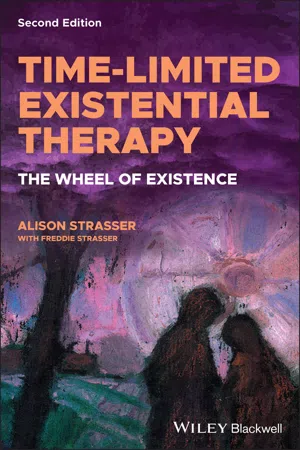
- English
- ePUB (mobile friendly)
- Available on iOS & Android
About This Book
Explore the concept of time as it applies to the therapeutic setting Following the innovative first edition which she co-authored with her late father, Freddie Strasser, in the newly revised Second Edition of Time-Limited Existential Therapy: The Wheel of Existence, distinguished therapist Alison Strasser delivers an insightful aid to integrating and working with existential givens as they arise within a therapeutic encounter. She locates the concept of Time as central to all therapies, regardless of their theoretical modality, and demonstrates how it can be used in brief, short-term, and open-ended therapies. The book relies on the concept of The Wheel to provide a framework for understanding existential and phenomenological philosophies and to help readers put them into practice with clients. It includes meaningful case vignettes that bring existential themes to life and is accessible to both therapists and interested lay members of the public. Finally, the author highlights how our experience with COVID-19 has impacted, and been impacted by, the existential themes we all deal with on a regular basis.
- A thorough overview of a commonsense existential approach and a discussion of the mystery of time
- Practical discussions of the limitations and possibilities of time-limited existential therapies, as well as concepts and methods in the area.
- Comprehensive explorations of the tyranny of high morality, and examinations of the body, the "givents" and "connectedness".
Time-Limited Existential Therapy: The Wheel of Existence is an indispensable resource for experienced psychotherapists, counsellors, social workers, coaches, and psychologists, as well as trainees in these fields seeking a common-sense approach to existential ideas in the context of therapy.
Frequently asked questions
Information
Part I
1
Existential and Phenomonological Philosophies and the Wheel of Existence
My freedom will be so much the greater and more meaningful the more narrowly I limit my field of action and … surround myself with obstacles … The more constraints one imposes, the more one frees one’s self of the chains that shackle the spirit.Igor Stravinski, Poetics of Music in the Form of Six Lessons (1970)
Existentialism and Phenomenology Overview
For the very essence of this approach is that it seeks to analyse and portray the human being – whether in art or literature or philosophy or psychology – on a level which undercuts the old dilemma of materialism versus idealism. Existentialism, in short, is the endeavour to understand man1 by cutting below the cleavage between subject and object that has bedevilled Western thought and science since shortly after the Renaissance.(May, 1983, p. 49)
The Wheel of Existence

Universalising: The Ontological Layer
The Ontological Givens
- Relationship in the ontological sense describes how a human being is always in a state of relationship not only to others but also to oneself and to the overall culture and environment. This understanding does not make any statements about the quality or the nature of the relationship but simply states the fact that relatedness reveals itself in the relationship.
- Facticity relates to the limiting factors that we cannot fundamentally change including certain features such as our own genetic makeup, our psychological profile, our cultural heritage, and our social world.
- Uncertainty and inconsistency is a feature of life that we cannot avoid and which the world imposes upon us.
- Temporality ‘is the name of the way in which Time exists in human existence’ (Warnock, 1970, p. 62) and nobody can escape from the idea that life is moulded by our finitude, that we are only transitory beings on this planet.
- Mood is the way we are ‘attuned’ to the world and describes how we are both experiencing and responding to our existence. ‘A mood assails us. It comes neither from “without” nor from “within”, but arises from Being‐in‐the‐world, as a way of that being’ (Heidegger, 1962, p. 136).
- Freedom is connected to responsibility in that humans are not determined by external factors which are certain, but, within the limitations of existence, are free to create their own responses to living.
- Embodiment denotes the concept that humans are both physical and non‐physical, are both mind and body. A body–mind experience will both shape and be shaped by our interactions in the world. ‘We are both subject and object, where the subject is his body, his world, and his situation, by a sort of exchange’ (Merleau‐Ponty, 1964, p. 72), where the object is subsumed into this exchange.
- Mortality is our constant awareness that we are moving towa...
Table of contents
- Cover
- Table of Contents
- Title Page
- Copyright Page
- Dedication Page
- Foreword
- Preface
- Acknowledgements
- About the Author
- Part I
- Part II
- Afterword: COVID‐19
- References
- Index
- End User License Agreement